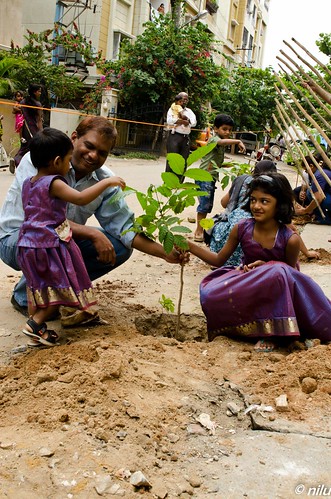The soiled hands of Aditi, Arush, Dev and their friends told a different story altogether. Their happiness knew no bounds as the youngsters carried saplings and buckets of water as part of a 2-day long tree plantation programme. This was organized by Rank Residency Apartment Owners’ Association at Kaggadasapura on 15th and 16th June, 2013 with assistance from Trees For Free treesforfree.org The area has been witnessing large scale felling of trees due to unplanned urbanisation and encroachment. A decision was made about replacing the lost green cover. Appropriately, the residents named the initiative as “Trees for Tomorrow”.
Anytime is right for good work. The advent of monsoon showers further motivated the residents. It was 10 o’clock on Sunday morning and the happy hour had arrived. Enthusiastic parents with their energetic little ones carried saplings to the pits that were kept ready by another team. Bamboo tree guards provided by Trees for Free, were firmly installed to ensure safety of the saplings. (The guards and saplings cost Rs. 250 per set). A total of 16 saplings that consisted of native varieties like neem, Jacaranda, Honge, Akash Mallige, Tabebuia, etc. were planted by 12:30 PM.

Young tree planters in action (pic: Poulami Sengupta)
The build up
Awareness regarding the planting activity was created through Facebook, email and poster notifications in the early stages. The expenses for the whole event totalling around Rs. 6000, were borne by a few individual residents and the association. Trees were also given for adoption to get back the money invested.
A Sit n Draw competition around the subject was organised the day before the event to build enthusiasm and gather more people. During this, 38 participants in two groups sat at a common place and drew based on a given topic within a stipulated time. Group A was for kids from ages 2 to 5 years while Group B was for childrens aged 7-14. Prizes were given for first, second and third position for Group B and a “special mention” category. For Group A, prizes were given to all. The prizes were unique ‘do-it-yourself’ kit with pots, seeds and instructions to set up the pot.
The participation was overwhelming with people of all age groups from toddlers to elders joining hands to plant trees. While most of the persons were from Rank Residency apartments, a few people from the neighbourhood also joined. This activity was the first of its kind organised by us. We are planning to plant more trees in the neighbourhood and conduct waste management and recycling workshops. The whole event was like a carnival with spontaneous participation, mesmerizing excitement and whole hearted volunteering. The fun and frolic ended with bliss in our hearts, swaying among the little green members and a pledge to see the world a greener one.